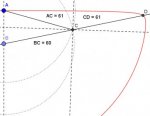Please help me with this practical problem.
1) ABC is a triangle
2) AB is vertical and A is uppermost,
3) AC=61 units,
4) BC=60 units,
5) AB is variable, point B can only move vertically up or down,
6) D is a point on the extension of BC, D is on the side of C and CD=61 units.
Questions:
1) As B moves up from its lowest point (ABmax = 61 +60 = 121 units), will point D ever rise above the horizontal line through A?
2) If it does, by how much vertical distance.
1) ABC is a triangle
2) AB is vertical and A is uppermost,
3) AC=61 units,
4) BC=60 units,
5) AB is variable, point B can only move vertically up or down,
6) D is a point on the extension of BC, D is on the side of C and CD=61 units.
Questions:
1) As B moves up from its lowest point (ABmax = 61 +60 = 121 units), will point D ever rise above the horizontal line through A?
2) If it does, by how much vertical distance.

